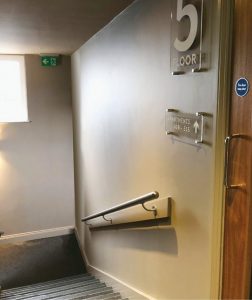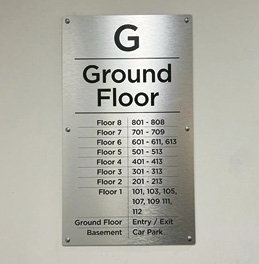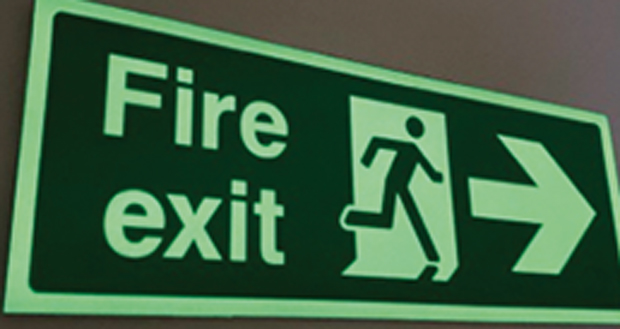 Changes to wayfinding signage regulations are a step towards taking H&S signage more seriously says John Davies, Managing Director at FASTSIGNS UK
Changes to wayfinding signage regulations are a step towards taking H&S signage more seriously says John Davies, Managing Director at FASTSIGNS UK
In 2018, it was revealed that ‘poor signage’ hindered rescue efforts at the Grenfell Tower fire in North London. Statements from members of the on-site emergency response team reported that navigating such a complex structure, without appropriate or clear signage, ultimately prevented them from carrying out their duties in full.
Since the findings of the ongoing inquiry were revealed, a recommendation in the Fire Safety Order was made that signage in multi-occupied high-rise residential buildings (over 11 metres high) now be a legal requirement in order to keep emergency services and residents safe.
As well as reminding us of the importance of clear, well-positioned signage, this regulation will, ultimately work to keep people safe in case of future disasters.
REGULATION CHANGES
Health and safety measures have always been stringent in the UK, but there have been some gaps in legislation. In most cases, health and safety signage is fundamental to ensuring that – should a disaster strike – responders are able to help businesses and people act to prevent harm and save lives.
We know that safety is any property and facilities managers’ top priority, particularly in the context of high-rise buildings, but the added costs to design and install signage, then later update it, can be off-putting.
There’s also the feedback from tenants, many of whom don’t want extra signage dotting their hallways and stairwells – this is a challenge that our network says happens most frequently in premium developments.
And, above all, there’s a grey area with regards to whose responsibility it is to ensure a space remains compliant and fundamentally, safe.
 This new regulation clears up those grey areas by assigning responsibility to one nominated individual in the building’s organisation. Their role is to personally ensure that a high-rise building remains compliant; any failings associated with that could result in heavy fines and at the very worst, prosecution. It also gives property and facilities managers the impetus to challenge residents who are opposed to more signage – often one of the greatest sources of disputes in commercial property leases.
This new regulation clears up those grey areas by assigning responsibility to one nominated individual in the building’s organisation. Their role is to personally ensure that a high-rise building remains compliant; any failings associated with that could result in heavy fines and at the very worst, prosecution. It also gives property and facilities managers the impetus to challenge residents who are opposed to more signage – often one of the greatest sources of disputes in commercial property leases.
A CHANGING PERCEPTION
We’ve seen a dramatic shift in attitudes towards directional and health and safety signage, not only since the Grenfell inquiry, but since the pandemic where health and safety signage has been invaluable. No longer was health and safety signage only restricted to settings like healthcare or building sites, it was everywhere you looked.
Floor decals, which were only really ever seen in theme parks and entertainment venues became commonplace. There was also signage on PPE, hand-washing and food handling guidelines, as well as social distancing signage to block off seating or walkways.
Digital signage in particular – a market that has seen exponential growth since 2021, likely as a result of the pandemic – also gave businesses a lifeline to continue working. The ability to provide real-time information, off-site, enabled many organisations in the UK to continue operating, while keeping staff safe.
I’m predicting – in light of the Fire Safety Order regulation, in response to the Grenfell inquiry – that this perception is set to remain.
Some argue that, as a society, we’ve become numb to signage since we’ve emerged from the pandemic. But, I believe, looking through a less nervous lens, that it’s made us more conscientious. It’s given us more understanding of the role that signage can play in our everyday lives.
Since the introduction of the regulation, we’ve heard that many of our franchisees have been called out to survey dozens of buildings. Our teams have visited businesses in previous months where little to no signage has been on display, so this outreach is already a huge step. This latest regulation will, hopefully, ensure that property and facilities managers are more aware of their responsibilities.
WIDESPREAD EFFECT
It’s not just the property or facilities management sectors that this affects. The report that was released as part of the regulation can be used as a guide for best practice for a number of industries, whether or not it’s a legal requirement.
 Take the education industry, and the running of monthly fire drills, for example. The logistics of that would be no easy task to manage – the person responsible would have to take care of teaching staff and communicate with hundreds of pupils, while not forgetting the scale of some school sites and the differing ages of those pupils. If the worst was to happen, this emergency would call for clear and easy-to-understand signage, to help those responsible make timely and informed decisions.
Take the education industry, and the running of monthly fire drills, for example. The logistics of that would be no easy task to manage – the person responsible would have to take care of teaching staff and communicate with hundreds of pupils, while not forgetting the scale of some school sites and the differing ages of those pupils. If the worst was to happen, this emergency would call for clear and easy-to-understand signage, to help those responsible make timely and informed decisions.
For me, no matter what perspective you look at this from, news of this regulation can only be seen as a positive step in the right direction. Safety is something that should never be taken for granted, and signage – with the right help at your disposal – can be a simple and preventative solution to keeping your teams, and those around you, out of harm’s way.





